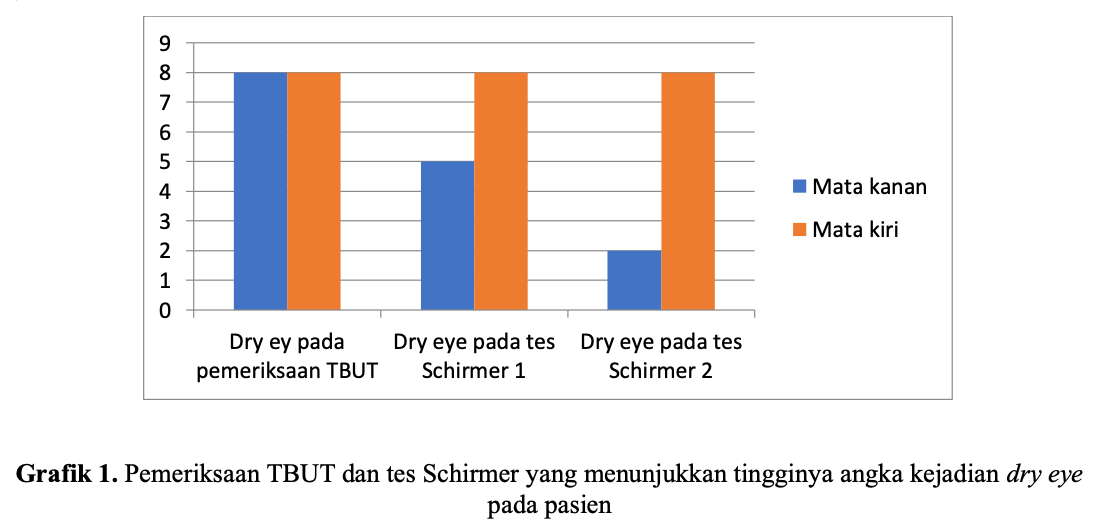Tear Break Up Time Pattern in Medical Students After COVID-19 Pandemic
Abstract
Introduction & Objectives
COVID-19 pandemic makes most activities are carried out online with using the VDT. Tear Break Up
Time (TBUT) examination is a short and fast examination and is able to determine damage to the
tear film and subjective examination using the OSDI Questionnaire. This study aimed to assess TBUT
pattern in medical students after COVID-19 pandemic regarding VDT used for online learning
activities.
Methods
This study is an observational analytic study with a cross-sectional approach. The difference in
proportion between TBUT results based on gender was analyzed using chi-square test. Statistical
analysis was carried out using a multivariate test based on the results of data normality. The oneway
ANOVA test is used for normally distributed data, while Kruskall-Wallis is used if the data is not
normally distributed.
Results
A total of 75 subjects were included in the study, consisting of 53 females (70,7%) and 22 males
(29.3%). Average use of VDT 8 hours per day. The average TBUT in both eyes were < 10 seconds
and random breaks was the most common pattern seen in this study (61,3% OD and 62,7% OS).
There was no significant difference between TBUT and gender but there was statistically significant
difference between OSDI score and TBUT.
Conclusion
Longterm use of VDT may be affect TBUT and subjective symptoms shown by OSDI score. Random
break was the most common pattern seen in young adults in relation with VDT use.
Full text article
References
Barabino S. (2022). Is dry eye disease the same in young and old patients? A narrative review of the literature. BMC ophthalmology, 22(1), 85. https://doi.org/10.1186/s12886-02202269-2
Bhattacharya, S., Saleem, S. M., & Singh, A. 2020. Digital eye strain in the era of COVID-19 pandemic: An emerging public health threat. Indian journal of ophthalmology, 68(8), 1709–1710. https://doi.org/10.4103/ijo.IJO_1782_20
Das A, Shah S, Adhikari TB, Paudel BS, Sah SK, et al. (2022) Computer vision syndrome, musculoskeletal, and stress-related problems among visual display terminal users in Nepal. PLOS ONE 17(7): e0268356. https://doi.org/10.1371/journal.pone.0268356
Pfefferbaum, B., & North, C. S. 2020. Mental Health and the Covid-19 Pandemic. 383(6), 510512. doi:10.1056/NEJMp2008017 Uchino M, Yokoi N,
Uchino Y, et al (2013) Prevalence of dry eye disease and its risk factors in visual display terminal users: the Osaka study. Am J Ophthalmol 156(4):759–766. https://doi.org/10.1016/j.ajo.2013.05.040
Uzun, S.L., Topcu, H. The relationship of distance learning with ocular surface disorders in students in the COVID-19 pandemic. Int Ophthalmol 42, 3045–3051 (2022). https://doi.org/10.1007/s10792-022-02290-w
Vargo, D, Zhu, L, Benwell, B, Yan, Z. 2020. Digital technology use during COVID?19 pandemic: A rapid review. Hum Behav & Emerg Tech. 1– 12. https://doi.org/10.1002/hbe2.242
Authors
Copyright (c) 2023 NI KADEK PUSPA MEGA PUTRI SUDIBIA, Ariesanti Tri Handayani

This work is licensed under a Creative Commons Attribution-NonCommercial-ShareAlike 4.0 International License.


